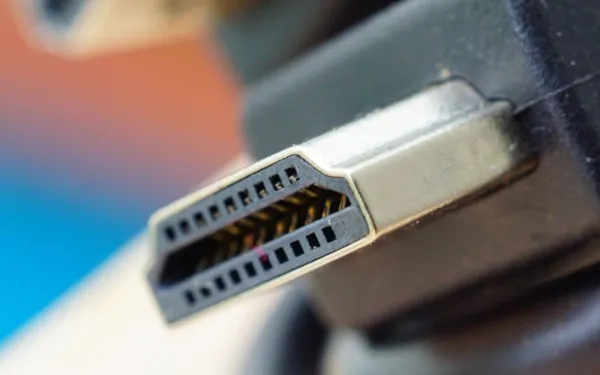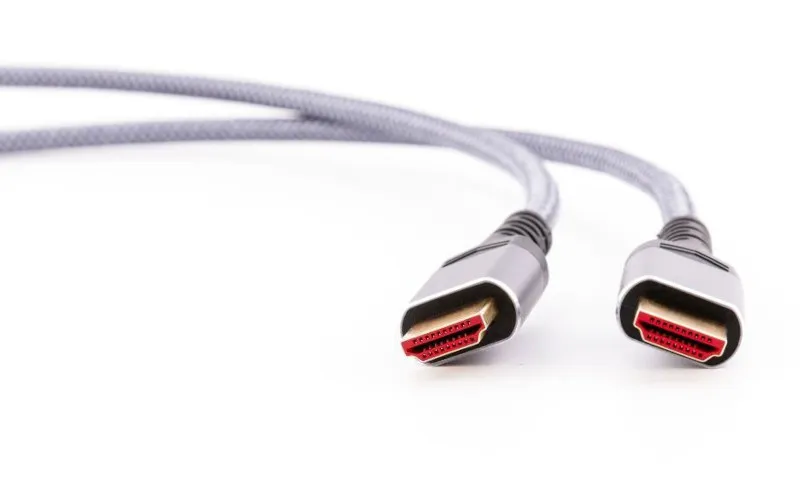As someone who’s spent much time around electronics, I’ve come to appreciate the small but significant parts that make our devices work seamlessly. One such component that often goes unnoticed is the HDMI cable.
This little marvel is vital to our modern technological life, connecting our devices and allowing us to enjoy high-definition audio and video content. But what does an HDMI cable look like?
If you’re unsure, don’t worry – you’ll easily identify one by the end of this article. So, please sit back, relax, and delve into the world of HDMI cables together.
The Basics of an HDMI Cable

An HDMI cable, short for High Definition Multimedia Interface, is a standard yet essential technology that most of us use daily, often without realizing it. The unsung hero brings your favorite shows, movies, and video games to life on your screen.
So, what exactly is an HDMI cable? At its core, it’s a conduit that connects two pieces of high-definition hardware, such as a Blu-ray player or a game console, to a TV or monitor. The bridge transmits audio and video signals from your device to your screen, making it a vital component in home entertainment systems.
Various types of HDMI cables are available in the market, each designed for specific uses and devices. For example, you have the Standard HDMI cable, which is perfect for most home applications, and then there’s the High-Speed HDMI cable designed to handle more data, ideal for 3D and 4K displays.
One of the key advantages of HDMI cables over older cables like VGA or DVI is that they can carry audio and video signals. This means you only need one cable, making the setup more accessible and less cluttered.
When purchasing an HDMI cable, durability is an essential factor to consider. A well-constructed HDMI cable should be sturdy and capable of withstanding regular handling. So, the next time you’re shopping for one, remember this.
An HDMI cable might seem like a small, insignificant part of your entertainment system, but enjoying high-quality audio and video content would be impossible without it. Next time you sit down to watch your favorite show or play a video game, spare a thought for the humble HDMI cable, working behind the scenes to bring your content to life.
Physical Characteristics of an HDMI Cable

Let’s now shift our focus to the physical characteristics of an HDMI cable. Knowing what one looks like is essential to easily identify it among cables behind your TV or computer.
HDMI cables come in various lengths and thicknesses depending on their use and the distance between the devices they connect. For instance, you might need a longer cable if your gaming console is across the room from your TV. They are typically coated in black rubber, but you might also come across ones in different colors.
You’ll find a connector on each end of the HDMI cable – this is the business end of the cable. The connector is typically gold-plated, though it can sometimes be silver, and has a distinct shape: it’s flat and wide, with one side slightly shorter than the other, forming an obtuse angle. This design ensures that the cable can only be plugged in one way, preventing damage to the ports.
If you look closely, you’ll see tiny holes along the connector – these are the pinholes. Most HDMI cables have 19 pinholes arranged in a specific pattern. These pins carry your device’s audio and video signals to your display.
So, next time you’re plugging in a device, take a moment to appreciate the humble HDMI cable. Its sturdy construction and clever design make it a crucial part of our digital lives.
Types of HDMI Cables
If you thought that all HDMI cables were the same, think again. Several types of HDMI cables are designed for different uses and devices. Let’s take a closer look at them.
- Standard HDMI Cable: This is your everyday HDMI cable. It’s designed to handle most home applications and can transmit 1080i or 720p video. The standard HDMI cable connects things like DVD players to your TV.
- High-Speed HDMI Cable: Also known as Category 2 HDMI, this cable can handle more data than the standard one. It’s designed for 1080p TVs and supports 3D and 4K displays. If you’ve got a gaming console, this is the HDMI cable you’ll want.
- Ultra High-Speed HDMI Cable: This is the latest and greatest in HDMI technology. It supports all HDMI 2.1 features, including 8K video at 60Hz and 4K at 120Hz. If you’re a hardcore gamer or movie buff with a state-of-the-art setup, this cable is for you.
- HDMI Ethernet Channel (HEC) Cable: This type of HDMI cable has an additional data channel that enables high-speed, bi-directional communication. Connected devices with this feature can send and receive data via 100 Mb/sec Ethernet.
- Automotive HDMI Cable: These are specially designed for use in vehicles. They have the same capabilities as a standard or high-speed HDMI cable but are made to withstand the rigors of automotive use.
So, next time you’re shopping for an HDMI cable, consider what you’ll use it for. Whether you’re setting up a simple DVD player or a high-end gaming system, there’s an HDMI cable designed to meet your needs.
Identifying an HDMI Cable
You might wonder, “How do I identify an HDMI cable among the sea of cables in my tech drawer?” Well, fear not because identifying an HDMI cable is pretty straightforward.
First, you’ll want to look at the ends of the cable. An HDMI cable has a distinctive, flat plug with one side shorter than the other, forming an obtuse angle. This unique design ensures that the cable can only be inserted one way into the port, preventing any potential damage.
Next, take a closer look at the connector. You should be able to see 19 tiny pinholes arranged in a specific pattern. These pins transmit your device’s audio and video signals to your display.
HDMI cables usually have the term ‘HDMI’ printed along the length of the cable, which is another easy way to identify them. They are typically encased in black rubber but can come in different colors, too.
Lastly, consider the size. HDMI cables are thicker than most other cables, like USB or Ethernet, due to the multiple layers of shielding used to prevent signal interference.
With these tips in mind, you should have no trouble identifying an HDMI cable the next time you set up your entertainment system or rummage through your tech drawer.
Conclusion
Appreciate how versatile and essential HDMI cables are in our digital lives. From the standard HDMI cable that connects your DVD player to your TV to the high-speed gaming and 4K display versions, there’s an HDMI cable for almost every need.
Identifying an HDMI cable is also pretty straightforward once you know what to look for—the distinctive shape of the connector, the 19 tiny pinholes, the ‘HDMI’ print along the cable, and its thickness compared to other cords.
Consider what you use it for when shopping for an HDMI cable. This will guide you to select the right HDMI cable for your setup. And don’t forget, the world of HDMI continues to evolve with technology, so who knows what exciting developments we might see in the future.
So, here’s to the humble HDMI cable, the unsung hero behind our binge-watching sessions, gaming marathons, and home movie nights. Keep on connecting!






